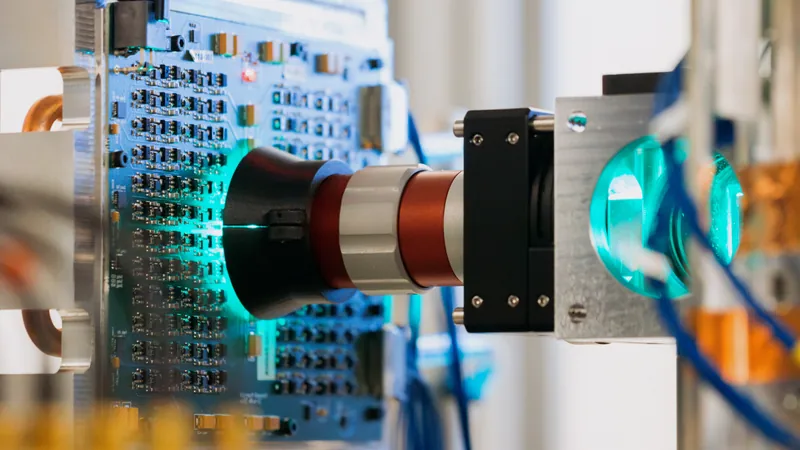
Astronomers Unveil Hidden Supermassive Black Holes from the 'Cosmic Dawn' Era!
2025-09-11
Author: Kai
A Groundbreaking Discovery in the Early Universe!
In a stunning breakthrough, astronomers using the Subaru Telescope in conjunction with the James Webb Space Telescope (JWST) have uncovered seven supermassive black hole-powered quasars, concealed beneath clouds of cosmic dust, dating back to the universe's infancy—less than a billion years after the Big Bang!
Cosmic Dawn: A Glimpse into the Past
The existence of these elusive quasars, known to blaze brightly while lurking in dust, has long been theorized to originate during a time in cosmic history dubbed "Cosmic Dawn." Recent findings suggest that their presence is likely twice as common as previously thought, providing researchers with a new understanding of the early universe.
A Tale of Two Telescopes
"This remarkable discovery was only made possible through the collaboration of two powerful telescopes," explained lead researcher Yoshiki Matsuoka from Ehime University, Japan. The Subaru Telescope’s expansive survey capabilities helped identify rare, brilliant galaxies, while JWST's ability to detect faint infrared light unraveled the mysteries of these hidden quasars.”
Both telescopes combined their strengths, showcasing an effective strategy: "Discover with Subaru, explore with JWST." This partnership allowed scientists to see through layers of dust that previously obscured their view.
Black Holes: The Engines of Creation
At the heart of galaxies in the universe today lies supermassive black holes—some weighing millions to billions of times more than our Sun. While some, like Sagittarius A* in the Milky Way, remain dormant, others actively consume surrounding matter, turning into spectacular quasars.
Quasars generate colossal amounts of energy as material spirals into them, releasing radiation that can be detected across cosmic distances. Their fiery existence may have played a crucial role in shaping galaxies and influencing the evolution of the universe.
The Mystery of Cosmic Dawn's Black Holes
Despite their brilliance, detecting quasars from Cosmic Dawn remains a challenge due to cosmic dust absorbing most of their ultraviolet emissions. But the research team turned the tide by focusing on galaxies emitting high-energy signals—yet lacking the typical indicators of quasars.
Utilizing the Hyper Suprime-Cam on the Subaru Telescope, they identified luminous galaxies that JWST later examined in infrared, revealing hidden quasars for the first time.
An Explosion of Findings!
Of the 11 galaxies surveyed, the team confirmed seven as quasars, exhibiting energy equivalent to trillions of Suns. Their black holes appeared to be billions of times heavier than our Sun, closely resembling unshrouded quasars found previously.
Astoundingly, the surrounding dust seems to absorb an astonishing 99.9% of the ultraviolet light and 70% of visible light emitted by these quasars—explaining why they remained so effectively hidden even from advanced telescopes.
Heading into the Future: More Discoveries Await!
With evidence suggesting that the number of shrouded quasars is comparable to their unhidden counterparts, researchers estimate that the population of quasars during Cosmic Dawn may be double previous estimates. The team plans to continue their exploration of these obscured realms, aiming to uncover the true nature of supermassive black holes in our early universe.
As they unveil these cosmic secrets, we inch closer to deciphering the incredible story of our universe's birth and evolution!




 Brasil (PT)
Brasil (PT)
 Canada (EN)
Canada (EN)
 Chile (ES)
Chile (ES)
 Česko (CS)
Česko (CS)
 대한민국 (KO)
대한민국 (KO)
 España (ES)
España (ES)
 France (FR)
France (FR)
 Hong Kong (EN)
Hong Kong (EN)
 Italia (IT)
Italia (IT)
 日本 (JA)
日本 (JA)
 Magyarország (HU)
Magyarország (HU)
 Norge (NO)
Norge (NO)
 Polska (PL)
Polska (PL)
 Schweiz (DE)
Schweiz (DE)
 Singapore (EN)
Singapore (EN)
 Sverige (SV)
Sverige (SV)
 Suomi (FI)
Suomi (FI)
 Türkiye (TR)
Türkiye (TR)
 الإمارات العربية المتحدة (AR)
الإمارات العربية المتحدة (AR)